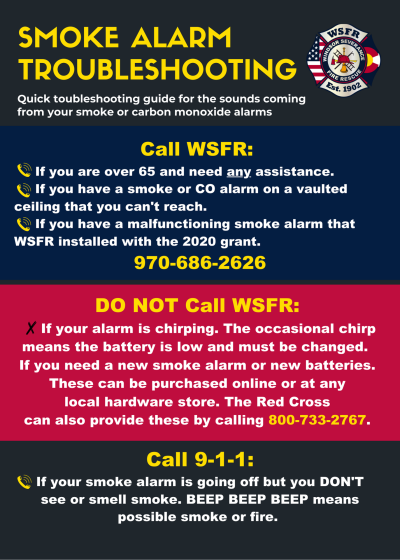Smoke Alarm Troubleshooting
Here is a quick guide to use if you are trying to figure out the sounds coming from your smoke or carbon monoxide alarms.

Alarm Sound Quick Guide
Smoke Alarm
- A continued set of three loud beeps - beep, beep, beep - means smoke or fire. Get out, call 9-1-1, and stay out.
- A single "chirp" every 30 or 60 seconds means the battery is low and must be changed.
- All smoke alarms must be replaced after 10 years.
- Chirping that continues after the battery has been replaced means the alarm is at the end of its life and the unit must be replaced.
Carbon Monoxide (CO) Alarm
- A continuous set of four loud beeps - beep, beep, beep, beep - means carbon monoxide is present in your home. Go outside, call 9-1-1, and stay out.
- A single chirp every 30 or 60 seconds means the battery is low and must be replaced.
- CO alarms also have "end of life" sounds that vary by manufacturer. This means it's time to get a new CO alarm.
- Chirping that continues after the battery has been replaced means the alarm is at the end of its life, and the unit must be replaced.
Additional information can be found on the NFPA website and below.
If you are a senior citizen over the age of 65 and need any assistance with your smoke or CO alarms, please call the fire department at (970) 686-2626.

Related Questions
We are happy to replace smoke alarms that we installed with the 2020 Grant for our senior citizens 65 and older. All smoke alarms provided by and installed with this grant are labeled as such.
For all other smoke alarms, we recommend hiring a local handyman.
Smoke detectors and carbon monoxide alarms can be purchased at your local hardware store or online. The Red Cross and its partners can also test existing smoke alarms and install up to three free smoke alarms for those who need them. The Colorado Region will provide installation services in the Colorado region only. Click here for more information.
No.
Three loud beeps (BEEP BEEP BEEP) or a vocal detector that says FIRE FIRE FIRE means smoke or fire. Get out quickly and call 911. If it chirps, that means that the battery is low and must be changed. Chirping that continues after the battery has been replaced means that the alarm is at the end of its life and must be replaced.
If you have detectors that need installed and you can’t reach them, the fire department can assist. If you have detectors that need a battery change and you have batteries that need installed, the fire department can assist. If you are a senior citizen over the age of 65 and need any assistance, please call the fire department at (970) 686-2626.
If your smoke alarm is mounted near a bathroom, it is possible that steam from the shower has set off the alarm. Alarms should be placed at least 36 in. (910 mm) from the bathroom door to eliminate the nuisance alarms from steam. Areas of high humidity or spaces with a humidifier can also cause issues with the alarm. If the smoke alarm is installed near a cooking appliance (stove, oven, etc.) it could falsely alarm, so consider moving the alarm further from the appliance.
A continuous set of 4 beeps: BEEP BEEP BEEP BEEP (or a voice telling you CARBON MONOXIDE has been detected) means that carbon monoxide (CO) is present in your home. CO does not have an odor but can be deadly. Go outside immediately and call 9-1-1.
Yes. In residences, even though your smoke detectors are “hard-wired” into the household electrical system, smoke detectors are equipped with a battery backup. For optimal reliability, WSFR recommends changing smoke detector batteries each time we change our clocks in the spring and fall for Daylight Savings Time. Change your clocks, change your batteries. During battery changes, take the time to remove any dust accumulation per the manufacturer's recommendations.
Smoke alarms have a service life of between 5-10 years depending on the manufacturer and model. Inspect the date on the smoke alarm and verify with the manufacturer's recommendation that the detector is within its service life. A detector that has exceeded its service life and is in use will give an indication or errantly generate alarms at some point.
